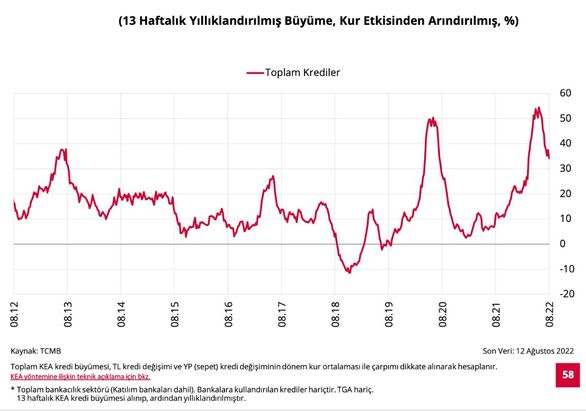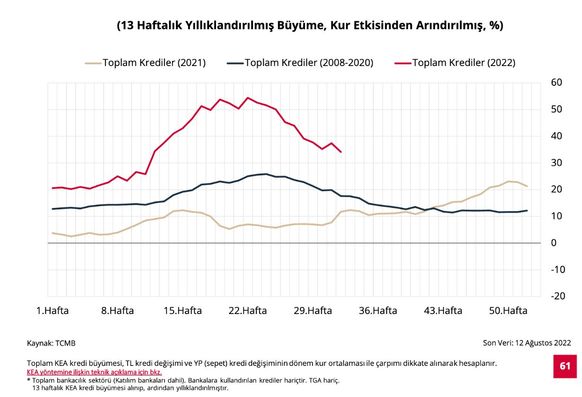Last week, the two decisions taken by the Central Bank, one day apart, were inconsistent with each other.
On Thursday, the Central Bank lowered the policy rate by one point to 13 percent, contrary to all central banks in the world, except for China. While inflation was at the highest in the world and other countries were raising interest rates, Turkey lowered interest rates.
One day later, on Friday evening, macroprudential measures were announced. While the loan interest rates were reduced, an environment was created to reduce the total use of loans.
Let’s start with the fasting part. The Central Bank took the most stringent, non-free market measures ever for loans and loan interest rates.
INCREASE OF MANDATORY PROVISIONS ON LOAN
➔ While only deposits of banks are subject to required reserves, some loans were included in the same scope with the decision taken on April 23, 2022. Both the resource and asset side of the banks were subject to reserve requirements. The range of movement and lending opportunities has been limited. Obligatory customers were made to government domestic debt securities.
The required reserve ratio, which started with 10 percent in April, was increased to 20 percent in May, and this ratio was increased to 30 percent with the communiqué on Friday evening.
➔For each 100 lira loan to be given, the bank will also set aside a 30 lira provision and invest it in government bonds with fixed interest rates of 5 and 10 years, defined by the Central Bank. The interest on the bonds can also be kept below the market rate.
➔SMEs, exporters, tradesmen, farmers, public companies and investments, corporate credit cards continue to be exempted from the 30 percent required reserve. Banks can give TL commercial loans to these companies.
However, the entire economy is not just about these companies. There are those who produce domestically, importers, and those in the service sector. Therefore, it seems that the decision will eventually have the effect of limiting credit expansion.
LIMITING INTERESTS IN LOWER DIRECTIONS
➔In determining the loan interest rates, the annual compound of the Central Bank’s policy rate will be taken as the “reference interest”. Thus, it is aimed to narrow the gap between loan rates and policy rates.
➔The compound of 14 percent was taken as 16.32 percent as the reference interest rate for August.
➔ Banks will be kept 20 percent securities if they extend loans exceeding 22.85 percent, which is 1.4 times of this.
➔ For loans with an interest rate of 29.38 percent, which is 1.8 times the reference rate, banks will have to hold 90 percent government securities.
➔The higher the interest rate, the higher the reserve requirement ratio will be. The bank should allocate 190 lira for a 100 lira loan with 30 percent interest.
➔ High interest is not prohibited, but the price is high. Under these conditions, it is very difficult for loan interest rates to exceed 29 percent. Credit appetite will be cut for defined companies.
HIGH INVOICE OVER THE LIMIT
In the period from July to the end of the year, the 10 percent threshold cannot be exceeded in loans subject to required reserves. If it is passed, 100 percent required reserves will be kept as much as the excess amount.
➔This shows that a high penalty is applied in case of exceeding the limits on credit use outside the desired areas.
➔The public sector has narrowed the playing field in the credit market. Even if credit utilization continues to increase for companies in the specified industries, it will decrease for other companies. It seems to decrease in total.
CREDITS DO NOT GROW, DECLINE
➔ the most suitable interest rate in lending is 16-22% band. Of course, companies want to use credit at this rate. Inflation is 80 percent for consumers and 138.5 percent for producers.
➔ However, private banks do not want to increase loans. Because the cost of the money they will receive from the Central Bank is 16 percent, and the deposit interest is around this. When tax burden, intermediation cost and credit risk are put on them, they rise above the 22 percent limit and there is no profit.
➔In this case, banks slow down their loans, starting with the riskiest and largest customers. Some banks may extend more than 22 percent for some of their customers to protect their market.
➔Public banks can also give loans because of their ownership and frequent capital reinforcement. The last 4 years of practice has been in this direction and The share of public banks in the loan cake increased from 35 percent to 50 percent. The amount of credit to be used here will be important.
Under these conditions, banks’ appetite for lending in total and loans are candidates to decrease.
Credit was already declining, as can be seen from the adjacent Central Bank’s charts. With the decision, it is aimed to continue this decrease.
➔Perhaps more importantly, sectors, companies and even the economy are discriminated against.
IS IT POSSIBLE TO EXPORT WITHOUT IMPORT?
➔ while reducing the application loans, it reduces the interest. It’s like an ambivalent situation that contradicts each other.
➔However, within the framework of selective credit policy Selected sectors such as SMEs, exporters, public companies, tradesmen, farmers, investments will receive cheap loans. Cheap resources will be transferred to companies in these sectors.
➔No cheap credit for others. Anyhow, it is considered that companies have foreign currency. Before using credit, they are asked to change their foreign currency.
➔These companies will probably do the same. They will ask not to use credit.
➔Large companies, importers, domestic producers, services sector companies and consumers, whose credit utilization is difficult, will pay the bill. These companies will experience the real difficulty.
➔ Among the importing sectors, there are chemicals related to the pharmaceutical industry, petroleum, fertilizers and feed in agriculture. Can the pharmaceutical industry work without importing? Is agricultural production possible?
➔More importantly, the import input of exports is at the level of 45 percent in total, according to the Central Bank. How to export without importing?
THE MOST CRITICAL EXCHANGE LIQUIDITY
➔This shows that the market, production, economy, companies, banks are parts of a whole, and if one of the parts stops, the system will break down.
As the loans slow down, the economy will naturally slow down, and imports will be braked. While the economy cools down, the need for foreign exchange liquidity will be kept under control.
Meanwhile, foreign currency inflows from Russia are increasing. There was a $15 billion increase in reserves.
➔ Foreign exchange inflows are also expected from Saudi Arabia, Qatar and the United Arab Emirates. It is stated that the total will reach 55 billion dollars.
➔A development that strengthens the reserves and meets the external debt repayments to be made in the coming months. But it will be a continuation, not a development that will provide a permanent flow. One-time boost.
➔External debt payments intensify in the coming months. The amount of external debt to be paid by the public and private sectors from September to April is 45 billion dollars. $5.5 billion falls each month. It is clear where the money will go.
➔In this context, macroprudential measures are a step towards balancing the foreign exchange liquidity, which has become the most important problem. The economy will have a slowing effect.
THE POLITICS OF REDUCING THE INTEREST
➔In this case, let’s come to the pickle part of the event, why the interest was reduced.. The purpose of lowering interest rates is not inflation, exchange rate or economic, but political. With 4 Presidents in 4 years, interest has now become a political indicator.
➔Behold President ErdoganThere was a promise made by s in June 2018 before the elections, “On the 24th, give this brother the authority and you will see how to deal with interest” saying.
Now the President will have kept his word in the upcoming elections. The rate that will be effective in election squares is an interest rate that will decrease to a single digit, that is, 9 percent.
➔ Inflation will be left until after the election. “First we lowered the interest rate, now it’s time for inflation. We will reduce it to single digits.” will be called. Anyway, in the opinion of the President, high interest rates are the result of high inflation.


